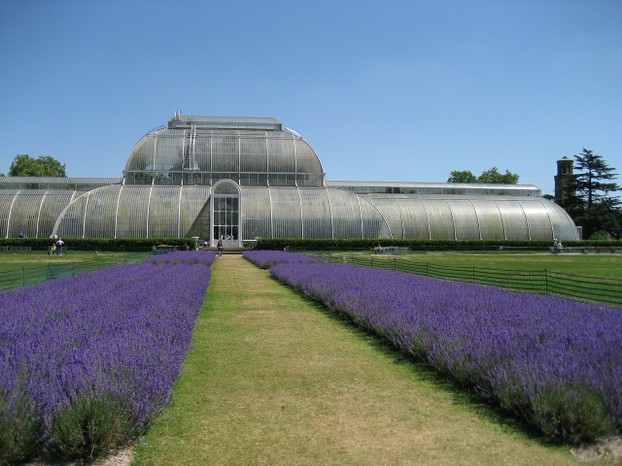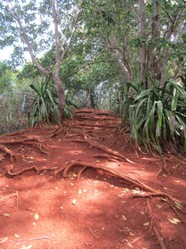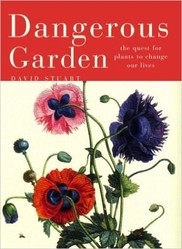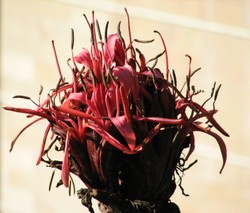One day he was struck by a puzzling thought. Why was the flower remaining so big and beautiful after it had done its male duty by producing pollen? Then came the moment of illumination, that creative flash that solves many a scientific problem. The plant was no longer male! He recalled that while most plants are bisexual certain plants undergo sex changes. Ramosmania must be one of those that go through male and female stages. The flower was now a beautiful female seeking to be pollinated. But in the feminization process it was no longer producing pollen and what pollen it had produced had become infertile with age, as pollen does not retain vigour for long.
The male stage preceded the female stage. By the time the plant turned female its pollen had aged, so the solution must be for the female to be fertilized by pollen from a new, young male flower. He chose a young flower , took some of its pollen and applied it. Then he waited. Then fruit appeared and they were sent to the micro-propagation unit.
This was not the end of the story, for he had to discover whether the seeds could be dried out, but fruits were coming in numbers sufficient to provide a stock of ready replacements. Over the course of a few months he collected 300 seeds.Then some of them were planted.
For days there was no visible progress, but then a seedling arose. But it was disappointing, for the seed had not released the leaves. Another failure! Then he noticed that some of the compost was slightly raised. Gently he blew it away to reveal another seedling. Within three weeks they had germinated. For the first time ever the species had been propagated in cultivation. Moreover, as far as Carlos knew, this was the first time that a seedling of this plant had been seen in a hundred years.
As time progressed Carlos noted that the young leaves were thin and he realized that this was a defence against being seen an eaten by Mauritius' resident tortoise population. He saw that they become larger only when the tree grows to higher than head height for a tortoise.
The return to Mauritius involved overcoming some problems, for the island's authorities quarantined the seedlings for a while, a necessary precaution against the import of diseases which could massacre the plant life of the small island. But Carlos had also brought six hundred seeds. These were eagerly taken by Mauritian gardeners keen to grow this survivor in their gardens. Since then he has planted six hundred seeds in the wild on the isle of Rodrigues, and about forty have grown into mature plants. The species had been saved.
In subsequent years Carlos earned the nickname of Plant Messiah [saviour] by working with endangered plant species across the world. His exploits are recounted in the book, The Plant Messiah."
The information here is taken from an article in The Horticulturalist, the journal of the Chartered Institute of Horticulture, Summer 2017. It was an edited extract of Carlos' book, The Plant Messiah.
Sadly I was unable to source a publishable photograph of Ramsmania.









 Pilgrimage. A review29 days ago
Pilgrimage. A review29 days ago
 Leo the Fourteenthon 05/09/2025
Leo the Fourteenthon 05/09/2025
 The Melsonby Hoardon 03/25/2025
The Melsonby Hoardon 03/25/2025



Comments
No.It does not
Thank you for your comment below in answer to my previous observation and question.
The Asturian and the Russian Wikipedias credit Carlos Magdalena with categorizing a water plant as the new species Victoria boliviana, classified incorrectly as Victoria amazonica 179 years ago!
This reclassification emerged in 2022, after The Plant Messiah.
Magdalena devoted 20 years to detailing Victoria amazonica in the Royal Botanic collection before deeming the original incorrect.
Does The Plant Messiah harbor any of his interactions with Victoria amazonica that entailed its name change 2 years ago?
I do not know.
Thank you for your comment below in answer to my previous observation and question.
Online sources describe cafe marron as a shrub maximally 1.5-plus meters (4.92-plus feet) tall even as they give no life expectancy for such a woody perennial!
Do we know how many survive now, in cultivation and in the wild?
Itnis an annual , I believe.
Thank you for your comment below in answer to my previous observation and question.
Cafe marron is such an attractive species. What might its life expectancy be generally?
Good article, but it would be better if in future you can share more about this subject. Keep posting.
As far as I know, only cuttings were taken, and as you know you can take cuttings without killing a tree, so I think that unless something bad has happened to it, the tree should still survive.
frankbeswick, Is the cafe marron whose profuse flowering attracted the biology schoolboy's attention still in existence?
True. Many people do not know that seeds respire very slowly and so use up energy, and s it is the case that small seeds run out of energy quicker than large ones. This is why gardeners who have been sold old seeds are unsuccessful.Seeds kept in cold conditions,of course,last longer. You are right about the possibility of a few older seeds growing, as the decay of the seeds probably follows a logarithmic curve.